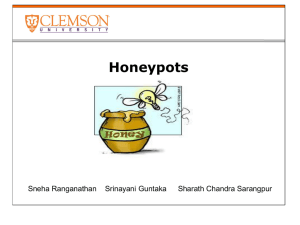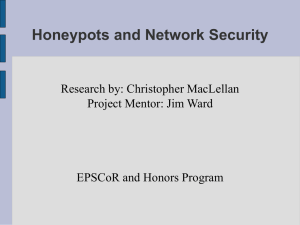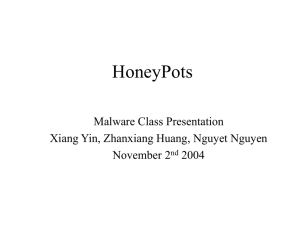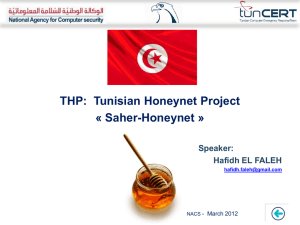Honeynets and Honeypots: Companion Technology for
advertisement
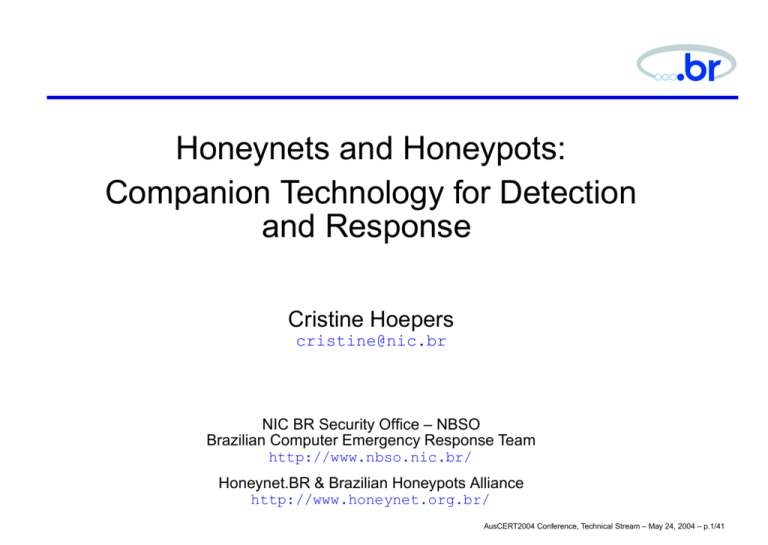
Honeynets and Honeypots: Companion Technology for Detection and Response Cristine Hoepers cristine@nic.br NIC BR Security Office – NBSO Brazilian Computer Emergency Response Team http://www.nbso.nic.br/ Honeynet.BR & Brazilian Honeypots Alliance http://www.honeynet.org.br/ AusCERT2004 Conference, Technical Stream – May 24, 2004 – p.1/41 Overview • Some definitions • Types of Honeypots – – differences possible uses • Types of data gathered – – in a Honeynet in a network of distributed honeypots • Additional Information AusCERT2004 Conference, Technical Stream – May 24, 2004 – p.2/41 Honeypot Definition “A honeypot is a security resource whose value lies in being probed, attacked or compromised.” Lance Spitzner, Honeypots: Tracking Hackers. AusCERT2004 Conference, Technical Stream – May 24, 2004 – p.3/41 Advantages • There is no “normal” traffic. Everything is suspicious and potentially malicious. • Less data to analyse than in IDS systems • Can provide valuable information about attackers • Can capture new types of malware AusCERT2004 Conference, Technical Stream – May 24, 2004 – p.4/41 Disadvantages • There are potential risks for your network (depending on the type) • Can be time consuming to maintain • Narrow view – sees only what is directed to it AusCERT2004 Conference, Technical Stream – May 24, 2004 – p.5/41 What honeypots aren’t • Honeypots are not replacements for: – security best practices – security policies – firewalls – IDS – patch management AusCERT2004 Conference, Technical Stream – May 24, 2004 – p.6/41 Types of Honeypots AusCERT2004 Conference, Technical Stream – May 24, 2004 – p.7/41 Low-interaction Honeypots • Easy to install and maintain • Low risk • Limited information gathering • Examples: – listeners, service emulators, honeyd, Tiny Honeypot. AusCERT2004 Conference, Technical Stream – May 24, 2004 – p.8/41 Low-Interaction Honeypots (cont.) • Emulate some parts of services and systems • The attacker does not have access to the real operating system • The attacker can’t compromise the honeypot (in theory) AusCERT2004 Conference, Technical Stream – May 24, 2004 – p.9/41 High-interaction Honeypots • More difficult to install and maintain • High risk • Need containment mechanisms • Extensive information gathering • Example: – honeynets, virtual honeynets AusCERT2004 Conference, Technical Stream – May 24, 2004 – p.10/41 Honeynet Definition (1) “A Honeynet is nothing more than one type of honeypot. Specifically, it is a high interaction honeypot designed primarily for research, to gather information on the enemy. [...] A Honeynet is different from traditional honeypots, it is what we would categorize as a research honeypot.” Lance Spitzner, Know Your Enemy: Honeynets AusCERT2004 Conference, Technical Stream – May 24, 2004 – p.11/41 Honeynet Definition (2) “A honeynet is a research tool consisting of a network specifically designed for the purpose of being compromised, with control mechanisms that prevent this network from being used as a base for launching attacks against other networks.” Cristine Hoepers, Klaus Steding-Jessen, Antonio Montes, Honeynets Applied to the CSIRT Scenario AusCERT2004 Conference, Technical Stream – May 24, 2004 – p.12/41 Honeynets Characteristics • A network of multiple systems and applications • Robust containment mechanism – may have multiple layers of control – sometimes called “honeywall” • Data capture and alerting mechanisms AusCERT2004 Conference, Technical Stream – May 24, 2004 – p.13/41 Honeynet Requirements • No data pollution (i.e. no test or traffic generated by non-blackhats) • Data control • Data capture • Data collection • Alerting mechanism AusCERT2004 Conference, Technical Stream – May 24, 2004 – p.14/41 Risks AusCERT2004 Conference, Technical Stream – May 24, 2004 – p.15/41 Low-Interaction Honeypots Risks • Compromise of the real operating system running the honeypot • The honeypot software may have vulnerabilities • Attract attackers to your network AusCERT2004 Conference, Technical Stream – May 24, 2004 – p.16/41 Honeynets Risks • A mistake in containment or configuration can – permit your honeynet to be used to harm other networks – open a port to your organization’s network • A compromise associated with your organization can affect its image • Your honeynet being identified AusCERT2004 Conference, Technical Stream – May 24, 2004 – p.17/41 Honeynets Risks (cont.) Why they are so risky: • Level of interaction – the attacker has full control of the machine • Complex to deploy and maintain – variety of technologies working together – multiple points of failure • New attacks and unexpected threats may not be contained or seen AusCERT2004 Conference, Technical Stream – May 24, 2004 – p.18/41 Possible Uses AusCERT2004 Conference, Technical Stream – May 24, 2004 – p.19/41 Possible Uses • Detect automated probes and attacks • Capture tools, new worms, etc • Identify insider’s attacks (internal honeypots, honeytokens) • Compare with IDS and Firewall logs • Raise awareness • Identify infected/compromised machines – use the data to generate reports AusCERT2004 Conference, Technical Stream – May 24, 2004 – p.20/41 When to Use Low-Interaction Honeypots • There is insufficient hardware to set up a honeynet • The risk of another type of honeypot is not acceptable • The purpose is: – – – – identify scans and automated attacks fool script kiddies distract attackers from important systems collect attack signatures and trends AusCERT2004 Conference, Technical Stream – May 24, 2004 – p.21/41 When to Use (cont.) High-Interaction Honeypots • The purpose is to observe the intruders activities and behavior: – – observe a real compromise IRC conversations • Need material for research and training in: – – artifact analysis forensic analysis AusCERT2004 Conference, Technical Stream – May 24, 2004 – p.22/41 Low x High-Interaction Honeypots Low-Interaction High-Interaction Installation Easy More difficult Maintenance Easy Time consuming Risk Low High Need Control No Yes Data gathering Limited Extensive Interaction Emulated services Full control AusCERT2004 Conference, Technical Stream – May 24, 2004 – p.23/41 Some Results AusCERT2004 Conference, Technical Stream – May 24, 2004 – p.24/41 Data Gathered Show some types of data gathered: • In a Honeynet of the Honeynet.BR Project http://www.honeynet.org.br/ • In a Network of Distributed Honeypots http://www.honeypots-alliance.org.br/ AusCERT2004 Conference, Technical Stream – May 24, 2004 – p.25/41 Data Gathered by Honeynets Honeynet.BR Topology Honeynet Forensics Administrative Network Honeypot 1 Hub Switch INTERNET IDS Honeypot 2 ... Router Firewall Hogwash Honeypot n AusCERT2004 Conference, Technical Stream – May 24, 2004 – p.26/41 Data Gathered by Honeynets (cont.) • Network traces of successful attacks – update IDS signatures – understand attacks • Profile of intruders – modus operandi – IRC conversations, motives – possible origin AusCERT2004 Conference, Technical Stream – May 24, 2004 – p.27/41 Data Gathered by Honeynets (cont.) • Rootkits, exploits, etc – Used to update the chkrootkit tool http://www.chkrootkit.org/ • New worms – Scan of the Month Challenge 25 – Analyze a worm recovered by a Honeynet. http://www.honeynet.org/scans/scan25/ – Propagation of "Slapper" OpenSSL/Apache Worm Variants http://xforce.iss.net/xforce/alerts/id/advise134 AusCERT2004 Conference, Technical Stream – May 24, 2004 – p.28/41 Data Gathered by Honeypots Brazilian Honeypots Alliance AusCERT2004 Conference, Technical Stream – May 24, 2004 – p.29/41 Data Gathered by Honeypots (cont.) • Low-interaction honeypots distributed over mulitple networks • Configuration of each honeypot: OpenBSD – Honeyd – listeners – • Data collection in 2 central points: NBSO/Brazilian CERT – CenPRA Research Center – AusCERT2004 Conference, Technical Stream – May 24, 2004 – p.30/41 Data Gathered by Honeypots (cont.) • Malware and spybot samples collected using listeners – – – mydoom kuang subseven • All traffic is logged (not only “SYN” packets) able to see signatures of attacks, scans and worms – reduce false positives – • Observe the “noise” of malware activity AusCERT2004 Conference, Technical Stream – May 24, 2004 – p.31/41 Data Gathered by Honeypots (cont.) • Sanitized data is being used by NBSO to: – notify Brazilian networks involved in malicious activity – donate data to other CSIRTs interested in notifying their constituents • Virus and malware are being sent to some AV vendors The following graphics are based on reports sent by NBSO to Brazilian Networks, in the first quarter of 2004. AusCERT2004 Conference, Technical Stream – May 24, 2004 – p.32/41 Data Gathered by Honeypots (cont.) 250 DCOM RPC (Blaster) Reports (cumulative) 200 150 100 50 0 10/Jan 24/Jan 07/Feb 21/Feb 06/Mar 20/Mar 2004 AusCERT2004 Conference, Technical Stream – May 24, 2004 – p.33/41 Data Gathered by Honeypots (cont.) 100 Kuang (17300/TCP) Reports (cumulative) 80 60 40 20 0 10/Jan 24/Jan 07/Feb 21/Feb 2004 06/Mar 20/Mar AusCERT2004 Conference, Technical Stream – May 24, 2004 – p.34/41 Data Gathered by Honeypots (cont.) 4000 Code Red 3500 Reports (cumulative) 3000 2500 2000 1500 1000 500 0 07/Feb 14/Feb 21/Feb 28/Feb 06/Mar 13/Mar 20/Mar 27/Mar 2004 AusCERT2004 Conference, Technical Stream – May 24, 2004 – p.35/41 Data Gathered by Honeypots (cont.) 450 openproxy scans 400 Reports (cumulative) 350 300 250 200 150 100 50 0 10/Jan 24/Jan 07/Feb 21/Feb 06/Mar 20/Mar 2004 AusCERT2004 Conference, Technical Stream – May 24, 2004 – p.36/41 Data Gathered by Honeypots (cont.) 4000 Dameware (6129/TCP) Mydoom 3500 Reports (cumulative) 3000 2500 2000 1500 1000 500 0 06/Mar 13/Mar 20/Mar 27/Mar 2004 Possible Agobot/Phatbot side effect AusCERT2004 Conference, Technical Stream – May 24, 2004 – p.37/41 Data Gathered by Honeypots (cont.) SYN packets received (log scale) Src Operating Systems 10M 1M 100K 10K 1K Windows Linux unknown Solaris NetApp NMAP OpenBSD Cisco FreeBSD Novell AusCERT2004 Conference, Technical Stream – May 24, 2004 – p.38/41 Data Gathered by Honeypots (cont.) 350000 Src IPs Origin 300000 Unique src IPs 250000 200000 150000 100000 50000 0 US CN JP KR CA BR FR DE TW UK AusCERT2004 Conference, Technical Stream – May 24, 2004 – p.39/41 Additional Information • Honeynet.BR Project http://www.honeynet.org.br/ • Brazilian Honeypots Alliance http://www.honeypots-alliance.org.br/ • The Honeynet Project http://www.honeynet.org/ • Honeynet Research Alliance http://www.honeynet.org/alliance/ • Honeypots: Tracking Hackers http://www.tracking-hackers.com/book/ • Know Your Enemy, 2nd Edition http://www.honeynet.org/book/ AusCERT2004 Conference, Technical Stream – May 24, 2004 – p.40/41 Additional Information • Honeyd http://www.honeyd.org/ • Honeyd: A Virtual Honeypot Daemon (Extended Abstract) http://www.citi.umich.edu/u/provos/papers/honeyd-eabstract.pdf • Honeynets Applied to the CSIRT Scenario http://www.honeynet.org.br/papers/hnbr-first2003.pdf • Honeynet Challenges http://www.honeynet.org/misc/chall.html • SecurityFocus Honeypots Mailinglist http://www.securityfocus.com/archive/ AusCERT2004 Conference, Technical Stream – May 24, 2004 – p.41/41

